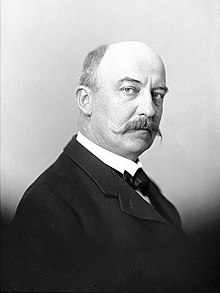
Back غابرييل ناروتوفيتش Arabic جابريل ناروتويكز ARZ Gabriel Narutowicz AST Габрыэль Нарутовіч Byelorussian Габрыель Нарутовіч BE-X-OLD Габриел Нарутович Bulgarian Gabriel Narutowicz Czech Gabriel Narutowicz German Γκάμπριελ Ναρουτόβιτς Greek Gabriel Narutowicz Esperanto
Gabriel Narutowicz | |
|---|---|
 Narutowicz in 1915 | |
| 1st President of Poland | |
| In office 11 December 1922 – 16 December 1922 | |
| Prime Minister | Julian Nowak |
| Preceded by | Józef Piłsudski (as Chief of State) |
| Succeeded by | Stanisław Wojciechowski Maciej Rataj (acting) |
| Minister of Foreign Affairs | |
| In office 28 June 1922 – 14 December 1922 | |
| Prime Minister | Artur Śliwiński Julian Nowak |
| Preceded by | Konstanty Skirmunt |
| Succeeded by | Aleksander Skrzyński |
| Minister of Public Works | |
| In office 28 June 1920 – 6 June 1922 | |
| Prime Minister | Władysław Grabski Wincenty Witos Antoni Ponikowski |
| Preceded by | Andrzej Kędzior |
| Succeeded by | Władysław Ziemiński |
| Personal details | |
| Born | Gabriel Józef Narutowicz 29 March 1865 Telšiai, Russian Empire (now Lithuania) |
| Died | 16 December 1922 (aged 57) Warsaw, Poland |
| Manner of death | Assassination |
| Political party | None (supported by the Polish People's Party "Wyzwolenie") |
| Spouse | Ewa Krzyżanowska |
| Children | Stanisław, Anna |
| Education | ETH Zurich |
| Profession |
|
Gabriel Józef Narutowicz (Polish: [ˈɡabrjɛl naruˈtɔvit͡ʂ]; 29 March 1865 – 16 December 1922) was a Polish professor of hydroelectric engineering and politician who served as the first President of Poland from 11 December 1922 until his assassination on 16 December, five days after assuming office. He previously served as the Minister of Public Works from 1920 to 1922 and briefly as Minister of Foreign Affairs in 1922. A renowned engineer and politically independent, Narutowicz was the first elected head of state following Poland's regained sovereignty from partitioning powers.
Born into a noble family with the strong patriotic sentiment, Narutowicz studied at the Saint Petersburg Imperial University before relocating to Zurich Polytechnic and completing his studies in Switzerland.[1] An engineer by profession, he was a pioneer of electrification and his works were presented at exhibitions across Western Europe. Narutowicz also directed the construction of the first European hydroelectric power plants in Monthey, Mühleberg and Andelsbuch. In 1907, he was nominated a professor of hydroelectric and water engineering in Zurich, and was subsequently assigned to maintaining the Rhine. In September 1919, Narutowicz was invited by the Polish authorities in rebuilding the nation's infrastructure after the devastation caused by World War I. On 23 June 1920, Narutowicz became the Minister of Public Works in Władysław Grabski’s government. Following his successful conduct of the Polish delegation at the Genoa Conference, on 28 June 1922 he became the Minister of Foreign Affairs in Artur Śliwiński’s cabinet.
During the elections in 1922, Narutowicz was supported by the center-left, most notably the Polish People's Party "Wyzwolenie", and by national minorities, but was criticized by the right-wing National Democrats. Far-right zealots, ultra-Catholic unions and nationalists targeted him for sympathy towards Polish Jews. Upon defeating the other candidate, Maurycy Zamoyski, Narutowicz was elected the first president of the Second Polish Republic. After only five days in office, he was assassinated by a mentally disturbed Eligiusz Niewiadomski while viewing paintings at the Zachęta Art Gallery.[2] His funeral, attended by almost 500,000 people, was simultaneously a manifestation of peace which diminished the power of the far-right movement in the upcoming years. Narutowicz was buried with honors on 22 December 1922 in the vault of St. John's Cathedral in Warsaw.
Narutowicz was a non-practicing Catholic and an active Freemason; he participated in rituals throughout the whole country.
- ^ "Gabriel Narutowicz". Archived from the original on 2019-09-20. Retrieved 2018-05-25.
- ^ Narutowicz Gabriel at Encyclopaedia PWN.
© MMXXIII Rich X Search. We shall prevail. All rights reserved. Rich X Search